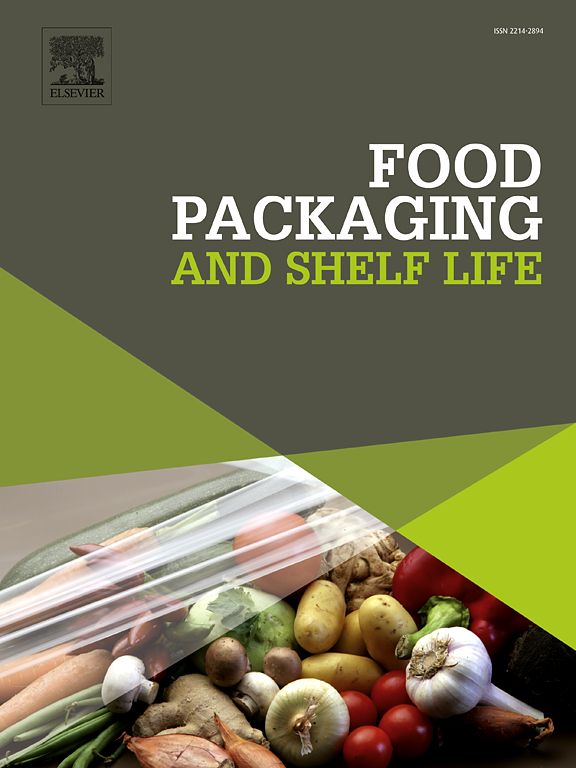反式聚辛烷橡胶除氧包装提高核桃保质期的研制
IF 10.6
1区 农林科学
Q1 FOOD SCIENCE & TECHNOLOGY
引用次数: 0
摘要
考虑到某些食物容易氧化变质,尤其是带壳坚果,食品科学和技术寻求减轻这些过程并延长产品保质期的方法。在新兴的技术方法中,活性包装系统,如氧气清除剂,已经获得了越来越多的关注。在这项研究中,柔性多层结构包含了两种不同浓度(10和20 % w/w)的新型氧清除聚合物-反式聚辛烷橡胶,tor。由于TOR在与氧反应后会释放挥发性化合物,因此所开发的多层结构在一层中加入了清除氧元素,夹在挥发捕集剂(蓖麻油酸锌和二氧化硅)层之间,并由乙烯-乙烯醇共聚物(EVOH)层作为氧屏障进行屏蔽。在工业化前的条件下,通过共挤层压法制备的最终十层结构薄膜具有良好的透明度、机械强度、优异的氧和水蒸气阻隔性能(23°C时为0.61 cc/m²day, 38°C时为3.18 g/m²day)和有效的保氧能力(10 %和20 % TOR时分别为8.0和15.2 mL/g)。这些薄膜应用于核桃的气调包装,与类似的被动十层结构相比,将顶空氧浓度从3 %降低到0.1 %以下。通过过氧化指数分析和与酸败相关的挥发性化合物在袋顶空间的积累以及感官测试来监测包装核桃的质量演变。这两个参数都表明,在两个月的储存后,清除剂提高了核桃的稳定性。感官测试也揭示了样本之间的显著差异。结果表明,新开发的清除结构可以有效地提高氧敏感食品的稳定性。本文章由计算机程序翻译,如有差异,请以英文原文为准。
Development of oxygen scavenging packaging with trans-polyoctenamer rubber to enhance the shelf life of walnuts
Given the susceptibility of certain foods to oxidative deterioration, particularly shelled nuts, food science and technology seeks methods to mitigate these processes and extend products’ shelf life. Among the emerging technological approaches, active packaging systems, such as oxygen scavengers, have gained increasing attention. In this study, flexible multilayer structures incorporating two different concentrations (10 and 20 % w/w) of a novel oxygen scavenging polymer—trans-polyoctenamer rubber, TOR—were developed. Since TOR releases volatile compounds after its reaction with oxygen, the developed multilayer structure incorporates the oxygen-scavenging element in one layer sandwiched between layers with volatile-trapping agents (zinc ricinoleate and silica), and shielded by an ethylene–vinyl alcohol copolymer (EVOH) layer acting as an oxygen barrier. The final ten-layer structure films, fabricated by coextrusion lamination under pre-industrial conditions, exhibited good transparency, mechanical strength, excellent barrier properties against oxygen and water vapour (0.61 cc/m² day at 23 °C and 3.18 g/m² day at 38 °C, respectively), and effective oxygen retention capacity (8.0 and 15.2 mL/g for 10 % and 20 % TOR, respectively). These films were applied in the modified atmosphere packaging of walnuts, reducing the headspace oxygen concentration from 3 % to below 0.1 % compared to a similar passive ten-layer structure. The quality evolution of the packaged walnuts was monitored through peroxide index analysis and accumulation of volatile compounds in the bag headspace associated with rancidity and a sensory test. Both parameters indicated that the scavenger improved walnut stability after two months of storage. The sensory test also revealed significant differences between samples. The results demonstrated that the newly developed scavenging structures can effectively enhance the stability of oxygen-sensitive foods.
求助全文
通过发布文献求助,成功后即可免费获取论文全文。
去求助
来源期刊

Food Packaging and Shelf Life
Agricultural and Biological Sciences-Food Science
CiteScore
14.00
自引率
8.80%
发文量
214
审稿时长
70 days
期刊介绍:
Food packaging is crucial for preserving food integrity throughout the distribution chain. It safeguards against contamination by physical, chemical, and biological agents, ensuring the safety and quality of processed foods. The evolution of novel food packaging, including modified atmosphere and active packaging, has extended shelf life, enhancing convenience for consumers. Shelf life, the duration a perishable item remains suitable for sale, use, or consumption, is intricately linked with food packaging, emphasizing its role in maintaining product quality and safety.
 求助内容:
求助内容: 应助结果提醒方式:
应助结果提醒方式:


